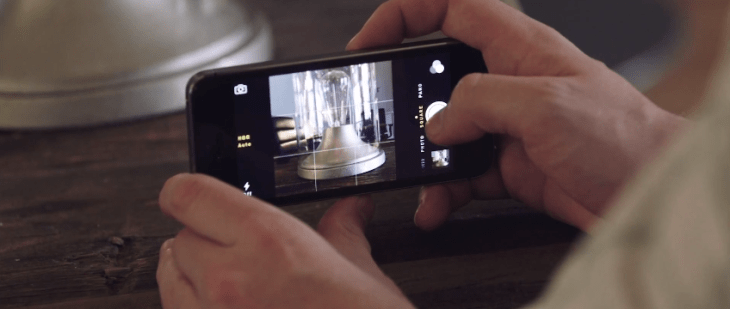Yesterday, tech and culture website The Verge revived This Is My Next, a brand that the core team had used to transition away from their places at Engadget into their new home at Vox Media. It’s not a new site, but instead a new vertical or type of post that tries to give a concise, authoritative answer to people wondering what gadget to buy.
The move is the latest in a trend: Using high-level editorial commentary to contextualize the vast array of information available on the web into digestible, actionable atomic units. At its heart, it’s a buying guide, but in the aggregate, it’s an explainer.
The first edition of This Is My Next is “the best smartphone you can buy,” which, the site says, is the iPhone 5s. That decision is backed by a series of reviews of various smartphones from The Verge over the past several months, which were tapped to build the final piece. The recommendation is coupled with a typically (for Vox) well-produced video which can act as a companion to or standalone version of the article.
“We talked about doing these types of reviews since launch and we never really had,” says Verge co-founder and Editor In Chief Joshua Topolsky. “We were so busy building and just making new stuff that we never sat down and said, “Okay. If we were going to do the…‘just tell me what to get review,’” or the Buying Guide Review, how do we do it, from a technology side?”
Topolsky says plans to resurrect the TIMN brand — which has been used a smattering of times over the course of the site’s 2 1/2 year history, but not consistently — began around six months ago.
The Verge is already well-known for its extensive reviews of gadgets, with polished design and video components. Some of that was carried over from Engadget, where many of the founding members previously worked together. But there has been some evolution of the style, with less primary focus put on specifications and more on editorial opinion. Still, Topolsky says that the reviews were not always suited to the kinds of recommendations that they wanted to give.
And, it’s easy to understand, not every purchase is worth writing or reading a 2-3,000 word review of. Some purchases are about getting the best value for the cost and making sure you’re not wasting your money — but not necessarily absorbing all of the technical information available on a topic. Sometimes you just want to know what the best thing is, period.
“I think we all do the same thing internally,” says Topolsky. “Even I do, when I was going to buy a new camera. I’m not, look I’m nerdy but I’m not going to review every camera to figure out which one is the best camera. I’ll go to David [Pierce] and say, ‘David, break it down for me, what’s the camera?’”
Pierce, who came to The Verge from PC Magazine, is familiar with granular, spec-driven reviews, but says that they’ve been thinking about doing reviews differently for a while.

“We had an all-hands meeting and were thinking about the future of each individual piece of what we do…and my whole sort of crusade was, let’s make reviews about more than just numbers. Let’s tell interesting stories and start to treat them more the way people treat film reviews and art reviews…let’s take these things as cultural criticism as much as buying advice.
“There’s this sort of Stockholm syndrome that can set in where you get something, and even if it’s not great or even good, you just — it becomes all that you know. And that just — that bums me out because, like, I just want to tell people it can be better. There’s better out there,” says Pierce.
For the moment, Topolsky says, This Is My Next will not become a separate site, but will remain part of The Verge brand.
“If we’re going to launch a new site about technology or about the future, it’s not just going to be about gadgets,” he says. “Increasingly, I think that as gadgets had become mainstreaming and normal like your grandmother has a smartphone and downloads apps and talks about her favorite Twitter client or whatever. I think it is a part of why we’re not a gadget blog. I think that was always sort of the proposition. We weren’t going to be a gadget blog. This to me is actually further away from what gadget blogging is. This is what actually human beings really need. It’s not for the guys in our forums.”
Cutting Through The Noise
This particular combination of aggregated review information from experts in the field, presented with a solid recommendation and some alternatives, was pioneered by Brian Lam at The Wirecutter, a site in The Awl network.
There are some similarities, and some differences, in the way that the two sites are approaching the model. The Wirecutter, for instance, links heavily to outside sources like expert reviews, consumer reports and independent product reviewers, and includes information from those experts in its recommendation essays. This Is My Next will pull wholly from reviews on the site — though Topolsky says that, in areas the site has not tackled, it will review items specifically to make a This Is My Next recommendation.
Both Pierce and Topolsky credit The Wirecutter for pioneering in this area.
“I love the Wirecutter first off and I think that Brian’s done a really awesome job with it and all of the spin-off stuff as well,” says Topolsky. “When you’re building something new, you’re going to look at everything that could be considered competition on this and the space. Honestly, for us, we’ve actually have done sort of like, ‘hey, which thing should I get?’ before. We actually did a, ‘here’s the smartphone you should buy on every area’.”
Topolsky says that the impetus for This Is My Next was to improve on the aggregated review model of sites like CNET, which have long relied on a numerically ranked database to provide buying recommendations.
“For us, I think that the big take, it was how can we actually make this digestible? That was a big one. Because I think that you read buying guides and…their goal is to be digestible but they’re really not. So we [said], ‘Is there a technology and an editorial standpoint that we can take that will make this more digestible?’”
In addition to having a distinct design, This Is My Next will also be using affiliate links to monetize the recommendations. This is an approach that has been taken by other publications, like The Wirecutter, but was previously seen as a tool for small independent publishers.
“Ultimately, we wanted to be able to give people the springboard to go buy something. Obviously, from a business perspective it makes sense,” says Topolsky. “But as a user, I was like, ‘what use are recommendations when there’s no action you can take after them?’. If you look at all our reviews and the way we approach gadgets and making recommendations to people is, how can we give you enough detail that you’d get the true sense and soul of the product without overflowing the info and making it not a approachable or readable document.”
Breaking Ground
“We didn’t make money for 18 months because it’s a huge moat in terms of Google. They hate lots of black hat affiliate sites that are scum,” says The Wirecutter founder Brian Lam. Lam founded the site in 2011 after leaving Gizmodo, where he served as Editorial Director.
Google, which is famously prickly about sites that it perceives as “hacking” search engine optimization to garner unwarranted page views and clicks, proved to be a difficulty early on for The Wirecutter. Because the site uses affiliate links for all of the products it tests, recommends or mentions on the site, it was slow going at first.
That algorithmic challenge, says Lam, acts as a sort of defense mechanism for The Wirecutter. Because the site was not funded by an outside firm, he had the freedom to play the long game and wait out the time it took to get the affiliate model to start paying off. 
“If you were to pitch a startup and you [said] ‘our startup is to make really long reviews that are never going to get good ad money and never do more than support themselves in a rich way.’ All VC’s that were smart would be like, ‘I mean that’s a good product, but it doesn’t sound like a good business.’”
Lam says that his experience, especially through the formative years of blogging, has given him a template by which to build a ‘traditional’ media company that could make a lot of money — for example, sites that produce shareable content that doesn’t require expertise in a specific area.
“If I wanted to build a media company that was going to make a lot of money, I know how to do that: make a lot of inventory, like lists and stuff that you can hire anyone who’s talented or not to do. That’s not that hard, I think.”
One of the things that Lam holds up as different with The Wirecutter is that its editors always seek out the best places for information on an item and the most experienced people in those fields. It then links out prolifically to those sources of information. It also generates its own testing and research, via the work of about 10 full-time staffers and 60 monthly contributors.
Lam says he will also include links to and information from This Is My Next, as he has with The Verge in the past.
“I think there is room for people to do this sort of thing. What I think I’ve seen in the past and I don’t think this is respectful, and I’m not saying [The Verge] is doing this, but I’ve seen this from other publications. We’ll do like a hundred hours of research on something and then someone else will do a blog post saying, ‘oh I like this by the way.’ And it’s a totally esoteric find that was at the bottom of the barrel that turned out to be the best thing by twice and half the cost, and it’s like, just link.”
Lam says The Verge getting into the space with a similar (though differentiated) model doesn’t change anything about the way The Wirecutter will proceed. “I’ve been making up new ways to do editorial my whole career and we’ve got some more stuff under our sleeves, too. We’re not sitting still.
“I think a part of what we did is not reviews; it’s just simulating the buying process, which is infuriating and terrifying,” says Lam. “People’s money is at stake and we never forget that. We don’t think this as another piece of content to monetize. We take it as, ‘what’s the most honest like truthful answer that we would give people we care about after doing dozens and dozens of hours of work? What would we get ourselves?’ And never really straying from that and that’s it. We’re focused on that.
“I tend to hire people that have really good work-life balance and like to go on little adventures because I need people who understand context and not just treating this like a factory job where [they’re] just pumping out content, but they’re really remembering every single reader is buying something and they’re trusting us with their money and it’s like — as long as we stay to that, I feel like we’re doing our thing and I’m satisfied.”
Information Glut
I have a feeling that the framework being tapped into by TIMN and The Wirecutter is a natural evolution of the gadget blog.
There was a point when blogs were the only sites that got down and dirty with every kind of gadget that spun up labs in apartments to test manufacturer claims and to be a consumer advocate. That was a valuable thing, and it became an obsession for a certain segment of the populace.
Now, however, technology is in the mainstream. It’s in the ground water.
Sites (or verticals) like these are also symptomatic of the fact that companies are specifically designing their products to not promote specifications; instead they’re being made to emphasize the user experience (something that was totally foreign to many industries just a decade ago).
As the devices themselves de-emphasize their inner workings — the iPhone is carefully designed so that anybody who’s ever touched the thing can use it — this is reflected in public perception. People are busier than ever and have been educated by the industry to care about how something works, not why it works. And sites like this are reflections of that.
When technology is everywhere and everything, how do you contextualize it?
I don’t think that there is anybody saying, “I want more noise and less signal.” I think that goes for the man on the street, just as much as the gadget-obsessed person who’s at their desk at work saying, “Crap! I read about this all the time but my phone just broke. Now I have to actually do something, not just absorb information. I need to make a decision. What phone do I buy?”
There have been some interesting moves in this direction in the past. Obviously PC World, Cnet, Macworld and other sites have been creating detailed, valuable review databases of products for a long time. But a database alone, or even a hyper-detailed review, does not always lead to a cleanly drawn consumer decision.
GDGT, founded by Gizmodo and Engadget alum Peter Rojas and Engadget editor Ryan Block, (and later acquired by AOL) took another interesting stab here with user-contributed ratings and product matrices. This brought us one step closer to an answer to the “what to buy?” question, but an over-reliance on numerical ratings and a lack of contextual glue caused it to fall short.
I’m not thinking that everybody chooses that path, but it’s cool how much stuff like The Wirecutter translates into the real world, which is where you just need stuff to be good. You want things to work, work right, and work a long time preferably so that you can concentrate on spending those two hours with your kid or your spouse or your mates or your partner or whoever — instead of figuring out what the best phone or sheets or chair to buy.
Who knows how far this will extend, but I think that it fits into the overall landscape in that the Internet is such a massive source of raw information. And it’s very thoroughly indexed and searchable for the most part. But having access to the information does not mean having access to the context — to the understanding. And that, if they’re smart, is where the next generation of publishers should be focusing their efforts.
“One of the things I was thinking is people now talked about — they’re like, ‘Yeah, everything’s mobile. You should think about mobile.’ The next thing is you’ve just got screens and interfaces and connected devices everywhere and it becomes so much bigger and so much broader and so much more ingrained in everything that we do,” says Topolsky. “The devices are changing, people’s attitudes on those are changing and I think that the coverage has to change.”
Article updated to note Pierce was employed by PC Magazine, not PC World.
